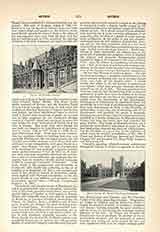

Gottfried von Strasburg, one of the greatest of Middle High German epic poets. Of his life we know absolutely nothing; even from his poem we derive no information on this subject. The dates of his birth and death cannot be accurately fixed, but a passage in the eighth book of his “Tristan and Isolt” furnishes a clue to the approximate date of its composition There Hartmann and Wolfram are mentioned as still living, while Reinmar of Hagenau and Heinrich von Veldeke are spoken of as deceased. From this it may be inferred that the poem was written about 1210. The fact that Gottfried is referred to by contemporaries as Meister, not Her, has been cited as proof that he was of the burgher class. But this is not certain. The title was sometimes given to denote learning, and might then be applied even to one of noble birth, and Gottfried certainly was learned for his time, since he knew Latin and French. Moreover he shows himself thoroughly familiar with the life of courtly society. It would seem that he was in easy circumstances, since he indulges in no complaints, so frequent with medieval poets, about poverty and lack of patronage. The supposition that he was a town clerk at Strasburg has been given up as unsupported by convincing evidence.
His great poem “Tristan and Isolt” is one of the most finished products of Middle High German literature. The story is briefly as follows. Tristan is seen by his uncle King Marke of Kurnewal (Cornwall) to woo for him the princess Isolde. On the home voyage the two young people by mistake drink a love-potion intended by Isolde’s mother for King Marke and his bride. As a result they fall madly in love with each other, and their illicit relations continue after Isolde’s marriage to Marke. Time and again they know how to allay suspicion, but at last Tristan has to flee. He meets and loves another Isolde, her of the white hands, but finds he cannot forget his former love. Here Gottfrieds poem breaks off. A continuation was written by Ulrich von Türheim (c. 1246) and Heinrich von Freiburg (c. 1300). According to this Tristan marries the second Isolde, but returns to Cornwall to enter on new love-adventures that culminate in the tragic death of the guilty pair.
Whether the Tristan legend is of Celtic origin, as it generally believed, or whether it arose in France, has not been definitely settled. Its literary development certainly took place in Northern France, where it was also loosely connected with the Arthurian cycle of romances. It was introduced into Germany about 1170 by Eilhart von Oberge, who based his poem on a French jongleur version. Gottfried cities as his source the poem of the trouvère, Thomas of Brittany, of which only a few fragments are extant. They begin unfortunately where Gottfried breaks off, and hence do not afford us a clear idea of his original. But Thomas’s version is preserved in a Norwegian translation made by a monk Robert in 1226 and in the Middle English poem of “Sir Tristrem”. Gottfried followed this version rather closely, and hence the merit of his work lies not in its composition, but in its style. This style is that of the courtly epic in its perfection. The rhyme is well nigh perfect, and the diction is clear and highly polished. Mannerisms are not wanting; antithesis, word-play, unnecessary repetitions, and an inordinate fondness for allegory foreshadow the decline of the epic that was set in after Gottfrieds death.
Gottfrieds poem is the most passionate love romance of the Middle Ages. Its wonderful psychologic art cannot be questioned, but its morality is open to severe criticism. Its theme is the sensuous love that defies moral law and tramples under foot the most sacred human obligations. That the pair act under the irresistible spell of a magic potion, to be sure, serves in a manner to attenuate their guilt. If Gottfried had lived to finish the poem, it may well be that he would have brought out more emphatically the tragic element of the story. In that case the poem would not have appeared to be a mere glorification of sensuous love.
Besides the Tristan nothing is preserved of Gottfrieds poetry except a couple of lyrics. A lengthy song of praise in honor of the Blessed Virgin was formerly attributed to him, but has been proved to be of different authorship.
Editions of “Tristan and Isolt” have been given by R. Bechstein (3rd ed., Leipzig, 1890) in “Deutsche Klassiker des Mittelalters”, VII, VIII, and W. Golther in Karschner’s “Deutsche National Litteratur”, IV (Berlin and Stuttgart, 1889). A critical edition has been published by K. Marold (Leipzig, 1906). Translations into modern German with additions to complete the story were made by H. Kurz (3rd ed., Stuttgart, 1877) and by W. Hertz (4th ed., Stuttgart, 1904). The legend also furnished to Richard Wagner the theme for his famous music-drama “Tristan and Isolde” (1859).
ARTHUR F. J. REMY

